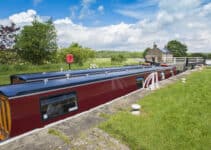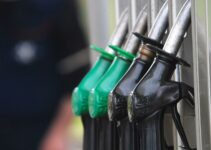Welcome back. Today, we are going over our narrowboat glossary. Canal boats are surprisingly complex and are made up of many different parts. Not only that, some of these parts have names that don’t make it immediately obvious what it is!
So if you are new to narrowboating, it’s time to learn all the weird and wonderful terms used! If you are a seasoned narrowboater, you never know. You still might not know all the technical terms 🙂
I haven’t gone into the painful details about every single nut and bolt on a canal boat either! We would be here all day and likely confuse anyone new! Instead, I tried to put the main terms that you are likely to hear!
Different Parts of the Narrowboat
In the Cockpit
Tiller
The tiller is the long (usually metal) pole that is used to steer the canal boat.
Rudder
A flat piece (of wood usually) used to steer the boat.
Swan’s Neck
This is a curved metal bar that connects the rudder with the tiller.
Cratch Cover
A fabric or plastic covering over the forward well deck.
Cratch Board
A board that supports the cratch covers at the front and is usually triangular.
Pram Canopy
Some kind of covering over the cockpit of the narrowboat, placed on a metal folding framework.
Weed Hatch
This is a box that can be opened (usually in the engine compartment) that allows you to get rid of weeds or other debris that might stop the propeller moving freely.
Well Deck
Refers to the floor of the cockpit.
Taff or Cant Rails
This is the rail around your boat’s stern. Sometimes known as Cant rails as far as I can tell (experts please tell me if I am wrong :))
Boat Hook
A pole with a hook on the end used to clear the propeller blades. This is a legal requirement for a narrowboat and is often seen on the roof close to the cockpit.
Inside the Narrowboat
Grey Water
Refers to the water from showers, sinks, washing machines, etc. This can be pumped straight into the canal, so please don’t use nasty chemicals 🙂
Black Water
This is the human waste that comes from your boat’s toilet. This has to be disposed of at designated waste points along the canal.
Reverse Layout
This layout has the galley/ kitchen area at the back of the boat and the main sleeping quarters at the front. This is the exact opposite of the traditional layout from back in the day 🙂
Boatman’s Cabin
The boatman’s cabin harks back to the days of the working boat. It’s the place where the live aboard workman (and possibly his family) would eat and sleep. These are still quite popular these days because of the traditional feel which usually incorporates a lot of painted decorations. I usually only see them on longer narrowboats, though.
Saloon
This is the ‘living room’ or lounge of the canal boat, where you will find sofas and watch TV etc. and relax.
Dinette
This is a table and chair arrangement that is often built in and used for eating on a narrowboat.
Galley
This is what you call the kitchen on a boat.
Bulkhead
I was a bit confused by the terminology here at the start, but this refers to the wooden walls that divide up your narrowboat.
Berth
A place where someone sleeps. When describing a boat, the number of berths is the number of people the boat sleeps.
Porthole
A round window in your boat.
Pigeon Box
A rectangular/ box shaped accessory fitted to the roof of your boat, that helps with venting.
Chimney/ Flue
The metal piping/tubing that is used to vent a stoves smoke out of your boat.
Mushroom Vent
A metal vent fitted to the roof of your boat to aid with venting. Guess what, it looks like a mushroom (kind of).
Inverter
This is used to convert the regular 12 volt power from your boat into a more ‘normal’ mains power supply found in a home on land.
Leisure Battery
These are the batteries used to power your appliances used for onboard living, such as fridges and water pumps.
Starter Battery
The battery used to start your boats engine.
Calorifier
A neat way to heat water whilst your boat’s engine is running. The hot water from the engines cooling system is passed through your water tank (often with a curly metal pipe) to heat the water inside.
Ballast
Materials used to balance how your boat sits in the water.
Cassette Toilet
A toilet with a changeable/ removable cassette that you need to empty every few days.
Macerating Toilet
A toilet that grinds up all of your human waste/ black water into a slurry that can be easily stored on your boat.
Incinerating Toilet
A toilet that turns your human waste into ash that can be easily disposed of.
Pump Out Toilet
A toilet that connects all the waste on your boat to a holding tank that has to be pumped out every few weeks.
Composting Toilet
A toilet that you put composting material into in order to naturally compost your human waste. When done properly, the output from this can be easily disposed of.
Holding Tank
The place where all your black water is stored on your boat. Weirdly, this is often stored under your bed 🙂
Outside the Narrowboat
Bilge
The bilge is the bottom part of your boat under the floors. A lot of people remember the bilge at the back of the boat by the engine, but don’t forget the cabin also has bilges.
Bilge Pump
This is the pump that will pump water out of the bilge areas described above.
Transom
This is the back part of the boat that connects both sides of the hull. In a narrowboat, it is often a curved or rounded section where the steerer stands.
Trad or Cruiser Stern
A trad stern is referring to a traditional stern, a small area at the back of the boat barely big enough for the person steering the boat.
A cruiser stern makes this area more social, as it is an extended area at the back of the boat not only used for steering. Several people can fit in this area, and it might even include seating.
There is a halfway house here called a semi-trad or semi-traditional style. It will give the appearance of a traditional stern, but will have a small enclosed area in front of the steerer with seats.
Fender
Fenders on a car allow you to bump into things without damaging the bodywork of the car. Fenders on narrowboats are the same, except they are made out of rope. You often have bigger rope fenders at the front and back of the boat, with smaller ones dotted along each side.
Stud & T-Stud
These are small accessories or attachments to your boat that you use to secure mooring rope on to. The t-stud has a t shape to it.
Anodes
These are small plaques or ingots (thanks Chris in the comments!) that are welded to the outside hull of your boat under the waterline. They aim to stop the formation of rust on your boat’ s hull and need to be changed every few years.
This is the light at the front of your canal boat, mostly used to see when navigating through tunnels.
Bow Thruster
These are thrusters at the sides of your boat to help you move sideways in the water. They are not that common in narrowboats, but can be useful for manoeuvering in tight spaces and passing others in windy conditions.
Beam
This is the measurement used to describe the width of canal boats. A regular canal boat will have a beam width of up to 6 foot 10 inches. Anything over this is classified as a wide beam boat, rather than a narrowboat.
Stern/ Aft/ Bow
In basic terms, the bow is the front part of your boat and the stern is the rear of your boat. Aft is referring to the back part of your boat behind the midline.
Narrowboating Organisations You Need to Know
CRT
CRT stands for the Canal and River Trust. This is the organisation that manages 96 of the waterways in England, who most boaters need to pay a licence fee to.
BSS
BSS stands for boat safety scheme, the organisation that helps you get a boat safety certificate required to get canal licences.
IWA
Stands for Inland Waterways Association, a charity that aims to protect the canal network in the UK. They are involved in restoration projects too. They have a membership program that helps support the charity.
EA
EA stands for the Environment Agency, a government agency that (among many other things) manages some of the rivers/waterways in the UK.
Other terms used in Narrowboating
Waste Point
These are the places that you can empty your black water on the canal network. An Elsan disposal point allows you to dispose of your cassette toilet black water, whereas a pump out point is somewhere you pump out your boats holding tank.
Shoreline
This refers to the shore power you can get (usually in marinas). It is a source of mains electricity you can plug your boat into.
On-line mooring & Off-line mooring
Most people think this is to do with finding moorings on the internet when they read these terms, although it actually has nothing to do with this 🙂
An online mooring is one which is by the side of the canal, alongside the towpath. Whereas an offline mooring is one of the main canal line, often in a marina.
Lock
A lock is something that allows a boat to change from one water level to another. The boat navigates into the chamber of the lock and (with lock gates keeping the water where you want it) the water level is either raised or lowered to enable the boat to come out the other side equalised with the water level of that part of the canal.
Staircase Locks
When you need to make big elevation changes, a series of locks are needed in a row. These are called staircase locks and are probably the most complex types of locks you will have to navigate on the UK waterways.
Lock Gate
There are usually two lock gates at each end of the lock chamber. When closed they stop the water from flowing in or out of the lock. These gates are opened when a canal boat wants to pass through.
Stop Lock
Most stop locks do very little these days, as they don’t usually change the water level of the canals. Back in the day they were used as toll stations for the canal operators to collect money from the passing boaters. Usually found in built-up areas around the canals, they can be identified as stone structures that narrow the canal down to a one boat wide path.
Swing Bridge
As the name suggests, this is a bridge that will swing in and out of position over a canal to clear the way for boats.
Lift Bridge
This is a bridge that will lift up and down to allow canal boats to pass under.
Stop Planks
Stretches of a canal that don’t use locks often have stop planks for emergencies. Often found positioned by bridges, these stop planks stop the flow of water when positioned over the canal. This allows management of the water flow/ levels in a canal, as well as the ability to drain parts of the canal for maintenance purposes.
Guillotine Gate
This is a type of lock gate that lifts up and down like an old fashioned guillotine. These are often made out of metal.
Ground Paddle and Gate Paddle
The ground paddle allows the flow of water from the canal into a lock. The outlets are placed low down in the lock, so do not disturb the boats inside the lock much.
A gate paddle is a piece of material that can be opened and closed on a lock gate to start or stop the flow of water from the outside canal into the lock. You usually open these after the ground paddles, as they can make the boats inside the lock more unstable.
Paddle Gear
This refers to the mechanism used to open or close the paddles on a lock.
Windlass
This is a metal tool used to wind the paddle gear at a lock.
Lock Cill/Sill
The cill is a raised ledge at the top end of a lock upon which the top lock gate sits when closed. This is marked by a white line at the side of the lock, as you want to keep your canal boat away from this cill when inside the lock.
Mooring Pin or Spike
This is a large metal pin that can be secured in the ground, giving you something to moor your boat on. These are usually used on the canal towpath when other mooring facilities are not available.
Blacking
This is the process of applying bitumen paint to the hull of your canal boat to stop rusting.
Over-Plating
When you repair rusty areas of your boat’s hull by welding metal plates on top.
Dry- Docking
In order to work on the hull of your boat, you will need to haul it out of the water and into a dry dock. A dock with the water drained away.
Continuous Cruising
This is a term used to describe someone that doesn’t stay in one place for any length of time. Instead, they continue to navigate around the canal network.
Aqueduct
Think of this as a metal bridge that flows water across it to allow a canal to run over them.
Gongoozler
Someone that takes great pleasure in watching canal boats in action. They are often found standing around locks.
Winding Hole
This is a widened section of canal used to turn large narrowboats around.
Wash
As your canal boat passes by, the water that is displaced to the canal banks is called the wash.
Wake
When you look behind a moving boat, you will see V shaped ripples or small waves in the water. This is the boat’s wake.
Towpath
This is a path that runs alongside the canal. Back in the day, you would see horses using the towpath to pull boats along. These days, it’s mostly for dog walkers and cyclists 🙂 When you moor up your boat, you should usually do this on the towpath side of the canal.
Are you all termed out??
That’s all the narrowboat terms we could think of. If there are any we forgot, please let us know in the comments section below.



![What Happened to Cruising The Cut [Narrowboat Youtuber]](https://canalboatuk.com/wp-content/uploads/2022/08/cruising-the-cut-youtube-channel-211x150.png)

Is the rudder normally wood? or more likely metal? (from a novice)
Metal these days.
Amused at the thought of Anodes being “plagues” on the hull! Are we talking Covid or Black Death? My understanding is that they are “plaques” or more easily described as “ingots”
Thanks:) As a solo blogger I do often miss such things 🙂
Another point on anodes. I don’t know how much use they are in preventing rust, but what they do is prevent atoms of steel being lost from the hull due to the electrolysis that takes place particularly when boats are moored up near each other and even more particularly when boats are connected to the same source of shore power. This pitting of the hull shows up at reblacking time the the boat is out of the water and if left untreated could ultimately lead to water leaking into the boat through a hole in the hull. The anodes lose their atoms more readily than the steel hull and for this reason they are sometimes called “sacrificial anodes”; the idea being that is is far less convenient to have to replace a steel hull than it is a small lump of magnesium, zinc or aluminium the three metals commonly used to offset electrolytic galvanisation. The type of anode depends on the sort of water the boat will mainly navigate. Narrowboats cruising inland waterways in fresh water are generally fitted with magnesium anodes.